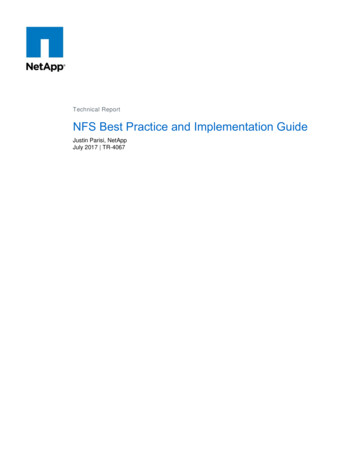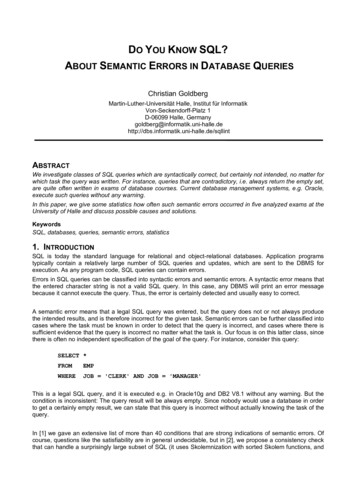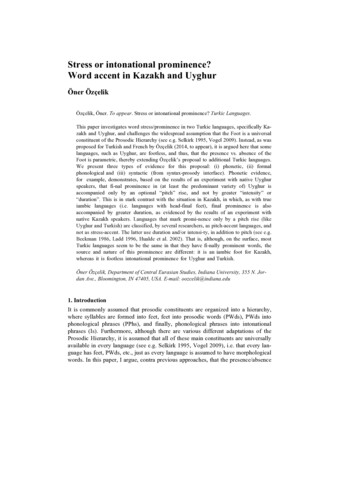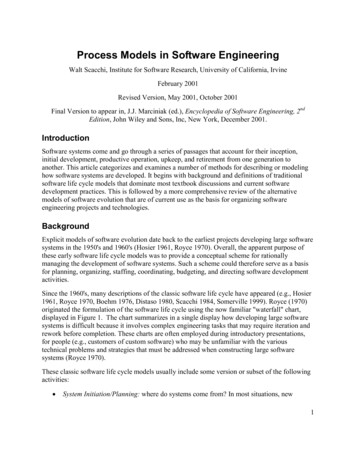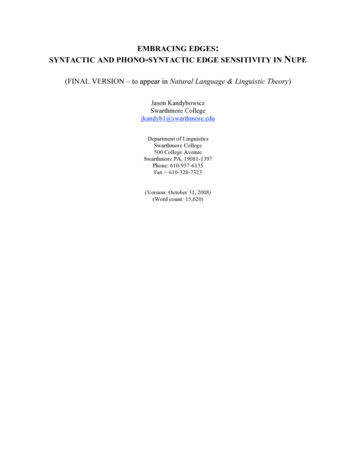
Transcription
EMBRACING EDGES:SYNTACTIC AND PHONO-SYNTACTIC EDGE SENSITIVITY IN NUPE(FINAL VERSION – to appear in Natural Language & Linguistic Theory)Jason KandybowiczSwarthmore Collegejkandyb1@swarthmore.eduDepartment of LinguisticsSwarthmore College500 College AvenueSwarthmore PA, 19081-1397Phone: 610-957-6135Fax 610-328-7323(Version: October 31, 2008)(Word count: 15,620)
EMBRACING EDGES:*SYNTACTIC AND PHONO-SYNTACTIC EDGE SENSITIVITY IN NUPE(to appear in Natural Language & Linguistic Theory)ABSTRACTThough well established as grammatical domains within phonology and morphology,edges have recently come to play a central role in both syntactic analysis and explanationwithin the Minimalist Program. This article adduces further empirical justification forthe inclusion of edges into the Minimalist ontology. By way of two case studies, it isdemonstrated that reference to edge domains in both the narrow syntax and at the syntaxphonology interface facilitates principled explanations to two unsolved puzzles in Nupe.The first study investigates a peculiar restriction on extraction from perfect domains. Themost tenable solution emerges when both phase edges and Edge Features are embraced.New insights into the nature of Edge Features arise as a consequence. The second studyconcerns the proper characterization of Comp-trace effects in the language. The mosttenable characterization emerges when they are viewed through the lens of the syntaxphonology interface. Comp-trace phenomena are shown to exhibit phono-syntactic edgesensitivity. New insights into the syntax-phonology interface arise as a consequence.KEYWORDSEDGE·MINIMALIST PROGRAMIMPENETRABILITY CONDITIONEFFECT···NUPE·EDGE FEATURES·PHASEEXTRACTION FROM PERFECT DOMAINS··PHASECOMP-TRACESYNTAX-PHONOLOGY INTERFACE1. IntroductionHistorically, the notion of EDGE as a grammatically sensitive domain has received strong supportfrom processes and interactions occurring in both the morphological and phonological wings of*This work has profited enormously from discussions with the following individuals whom I would like to thank: Mark Baker,John Bevers, Daniel Büring, Ivano Caponigro, Brent de Chene, Chris Collins, Marcel den Dikken, Danny Fox, Bruce Hayes,Nina Hyams, Ángel Gallego, Ken Hiraiwa, Ahmadu Ndanusa Kawu, Ed Keenan, Chris Kennedy, Hilda Koopman, LisaLevinson, Thomas Leu, Anoop Mahajan, Jason Merchant, David Pesetsky, Carson Schütze, Tim Stowell, Harold Torrence,Raffaella Zanuttini, and Eytan Zweig. I am especially grateful to three very thorough and enthusiastic NLLT reviewers whosecomments greatly helped elevate the quality of this article. Thanks also to the participants of WCCFL 25, WCCFL 26, andaudiences at UCLA, MIT, University of Chicago, University of Florida, Georgetown University and CUNY Graduate Center,where portions of this material were presented.The data presented in this article comes exclusively from fieldwork and represents the judgments of seven native speakers ofthe dialect of Nupe spoken in the towns of Lafiagi and Patigi. Abbreviations used in the glosses of examples sentences are asfollows: COMP – complementizer; EMPH – emphatic particle; FOC – focus; FUT – future; LOC – locative marker; PL – plural; PRF –perfect; PRS – present; PRT – particle; PST – past; REL – relativizer/relative clause particle; SG – singular. The orthographicrepresentation of Nupe employed in this article conforms to the modern spelling system (cf. Madugu 1980) and thus differsslightly from the classic orthographies of Banfield (1914) and Banfield & Macintyre (1915). In what follows, high tone ismarked with an acute accent over the vowel and low tone is marked with a grave accent. Mid tones are unmarked. Nasalizedvowels are represented by the sequence V n (e.g. an is the notation for the nasalized vowel [ã]). Labiovelar phonemes arealso transcribed as sequences of graphemes (e.g. kp and gb ). Vowel length is indicated by means of a colon following thevowel and contour tones are transcribed as sequences of level tones (e.g. a rising tone on the vowel [a] is transcribed a& ).2
grammar.1 Recently, edges have come to play a prominent role in syntactic analysis, referencing the leftperiphery of a phase - a domain that includes the phase’s head, specifier, and adjunct positions. As withany theoretical innovation or shift in perspective, two crucial issues are raised. First, how principled isthe innovation? Second, what advantages does the new conceptualization offer over the old? This articleaddresses the latter question by way of case studies of two independent phenomena in Nupe, a BenueCongo language related to Yoruba that is spoken in south central Nigeria. I show that reference to edgesin both the narrow syntax and at the syntax-phonology interface facilitates principled explanations to twolong-standing unsolved puzzles in the Nupe literature. The argument is thus that a syntactic theory thatembraces edges is indeed desirable from an analytical standpoint.The first case study showcases narrow syntactic edge sensitivity. A puzzle perennially observed inthe Nupe literature is that extraction from tensed clauses is possible, but extraction from perfect clauses isnot (Smith 1967, Kandybowicz & Baker 2003).2(1)a. Ké Musa è/àpao?what Musa PRS/FUT poundFOC‘What is Musa pounding?’/‘What will Musa pound?’b. *Ké Musa ápao?what Musa PRF poundFOC‘What has Musa pounded?’[Present/Future TP][Perfect TP]I argue that the existence of EDGE FEATURES (Chomsky 2007, 2008a), that is, features responsible fordriving cyclic movement to phase edge positions in compliance with the PHASE IMPENETRABILITYCONDITION (Chomsky 2000), allows for an elegant solution to this puzzle. In addition, I show that theproblem of Nupe perfect extraction sheds light on the very nature of the purported Edge Features that areborne by phase heads. Contra Chomsky (2007, 2008a), I argue that Edge Features are not inherentlyactive properties of phase heads (as least for the v phase), but are rather features that, depending on thehead that bears them, require activation. In this way, the possibility arises that a given phase head’s EdgeFeatures may either be active or lie dormant in the narrow syntax. I contrast this variety of Edge Feature(i.e. the kind borne by phase heads) with the variety present on non-phasal heads. The resulting system, Ipropose, is one in which the operation Merge is driven by two sorts of Edge Feature; one for ExternalMerge and another for Internal Merge (i.e. movement), the two fundamental Merge operations standardlyattributed to UG.The second case study showcases sensitivity to the edge at the syntax-phonology interface. Longdistance A-bar movement in Nupe exhibits clear Comp-trace effects. Objects, but not subjects, may crossovertly realized embedded complementizers. This subject-object asymmetry is illustrated below.(2)a. *Ze& Musa gàn [gànán nìenyà] o?who Musa say COMPbeat drum FOC‘Who did Musa say beat a drum?’[* Subject extraction across C]b. Ké Musa gàn [gànán etsu nì ] o?what Musa say COMP chief beatFOC‘What did Musa say that the chief beat?[ Object extraction across C]1Chris Kennedy (personal communication) points out that edges are more the exception than the rule in two domains: semantics,where edges taken to correspond to extension boundaries are often obscured by vagueness, and phonetics, where overlappinggestures represent a clear blurring of articulatory and categorical boundaries.2I address the issue of the underlying word order of structures like those in (1) directly in section 2.2.1.3
The puzzle in this case is that a seemingly unrelated range of options exists in the language for repairingComp-trace structures. These options include the following: phonological reduction of C; insertion ofTP-adjoined adverbials; resumption of the displaced occurrence; and spelling-out tense markers. I arguethat Nupe Comp-trace effects can be reduced to violations of the INTONATIONAL PHRASE EDGEGENERALIZATION (An 2007a), a PF output condition requiring that the mapping from syntax tophonology result in outputs in which the syntactic edge of every obligatorily parsed prosodic phrase isphonetically delimited. I show that the seemingly disparate strategies of Comp-trace resolutionpreviously mentioned follow naturally as a consequence.Taken together, these case studies furnish additional support for the edge/phase-based directioncurrently being explored in the Minimalist Program. Furthermore, the empirical facts presented in thisarticle, both new and striking in a purely descriptive sense, provide decisive evidence in favor of severaltheoretical reappraisals. These technical innovations arise throughout the course of discussion in bothcase studies.2. Case Study 1: Nupe Perfect Extraction2.1 Problems and GoalsThe restriction on extraction from perfect domains is an old and yet unsolved problem in the Nupeliterature that was first pointed out by Smith (1967). The data below illustrate the extraction asymmetry.(3)[Past TP3]a. Ké Musa pao?what Musa poundFOC‘What did Musa pound?’b. Ké Musa èpao?what Musa PRS poundFOC‘What is Musa pounding?’[Present TP]c. Ké Musa àpao?what Musa FUT poundFOC‘What will Musa pound?’[Future TP]d. *Ké Musa ápao?what Musa PRF poundFOC‘What has Musa pounded?’[Perfect TP]The first case study investigates this extraction restriction and explores its theoretical consequences forthe notions of edge and Edge Feature in the current Minimalist framework. To this end, I confront twotypes of goals. My empirical goal is simply to derive the extraction facts laid out in (3). My theoreticalgoal is to determine the extent to which Minimalist technology facilitates an adequate explanation of theNupe perfect extraction restriction. With respect to the theoretical goal, I will advance two positions.First, the existence of edges and Edge Features (Chomsky 2007, 2008a) allows for an elegant account ofNupe’s restriction on perfect extraction. And second, contrary to Chomsky’s conception of them, EdgeFeatures come in two varieties, namely, EXTERNAL EDGE FEATURES (inherently active features that driveExternal Merge) and INTERNAL EDGE FEATURES (dormant features requiring activation that drive InternalMerge). In the coming sections, I familiarize the reader with the technical concepts previously appealedto and elaborate further on my proposal.3Unlike other tense markers in the language, the exponent of the past tense morpheme in Nupe is .4
2.2 Deriving the Nupe Perfect Extraction Restriction2.2.1 The Syntax of Perfect and Tensed Clauses in NupeI begin by laying out an account of Nupe clause structure. The analysis presented here forms thebackbone for later discussion. With one or two minor twists, the syntactic analysis presented in thissection is the analysis put forth in Kandybowicz & Baker 2003. Space considerations preclude a morelengthy discussion of basic Nupe syntax. The interested reader is invited to consult Kandybowicz &Baker 2003 and Kandybowicz 2008 for further justification of the claims made in this subsection. Inwhat follows, I assume a basic understanding of the Agree-based multiple spell-out system of Chomsky2000, 2001, 2008a, although I do elaborate on certain crucial aspects of the framework in later sections.Although the structures in (3) appear to be identical, one can show quite easily that they are not. Toreach this conclusion, however, a few observations are in order. First, both VO and OV word orders areattested in Nupe. In a manner very much reminiscent of Gungbe (Aboh 2005), Vata and Gbadi(Koopman 1984), the surface word order of a Nupe verb phrase depends on the clause’s tense/aspectspecification. The verb’s argument structure plays a role as well. As shown in the data below, simpleaccusative transitive sentences in a variety of (non-past) tenses manifest the VO word order (4a),however, when the perfect marker á is present (4b), one finds OV orders instead. When the verb selects alocative argument in the perfect, however, VO order resurfaces (4c).(4)a. Musa è/àsidùkùn.Musa PRES/FUT buy pot‘Musa is buying/will buy a pot.’[VO]b. Musa ádùkùn si.Musa PRF potbuy‘Musa has bought a pot.’[OV]c. Musa álekata-o.Musa PRF sleep room-LOC‘Musa has slept in the room.’[VO]Second, tense markers are independent particles in the language, not verbal prefixes. Evidence comesfrom the fact that low VP-initial adverbs come between tense morphemes and verbs (as in English), notbefore T4 or after the tense verb string (as in French).5 In this way, we have evidence that verbs do notraise to T in the language, even though they precede objects in non-perfect clauses. (5) shows this pattern4Smith (1967, 1969:124) gives examples of tense markers occurring both before and after low VP-initial adverbs like dàdà‘quickly’ (contra the data reported in (5)), an unexplained and otherwise mysterious distribution for him. This distribution isunattested in the grammars of my consultants, all of whom systematically reject sentences in which adverbs like dàdà arepositioned before a tense marker.Since Nupe (like Yoruba and other related languages) lacks an open class of morphosyntactic adverbs, it is possible to regardthe expression dàdà in (5) as a serialized activity predicate meaning ‘hurry’ (along the lines of a “preverb” (Smith 1967, 1969,1970)). Two facts, however, argue against this position. One, Nupe, like many West African languages, imposes prosodicminimal word requirements on its nominal and verbal categories. Nominal expressions are minimally bimoraic, while verbalones are maximally monomoraic (Kawu 2002). The prosodic properties of the expression dàdà clearly do not pattern with thoseof the verbal category, making it more likely that dàdà is adverbial rather than verbal. Second, evidence against an analysis ofdàdà in terms of a serialized activity predicate comes from the fact that it can freely co-occur with inanimate subjects. Arepresentative example is provided below. Thus, the expression imposes no selectional restrictions.5(i)Tákùn dàdàcín ya.rock quickly drop cast-off‘The rock quickly dropped.’5
for the future marker and the present tense morpheme; the same pattern holds for other choices of lowVP-initial adverbs (not shown).(5)Musa (*dàdà)à/édàdàsi (*dàdà) dùkùn.Musa quickly FUT/PRS quickly buy quickly pot‘Musa will quickly/is quickly buy/buying a pot.’A third (and crucial) observation is that the perfect marker á is the exponent of a head lower than T.Support for this claim comes from the fact that the same VP-initial adverbs that necessarily follow T (cf.(5)) must precede the perfect morpheme (cf. (6a) below). Additionally, certain tense markers may cooccur with the perfect particle (cf. (6b)), illustrating that the two morphemes are not in complementarydistribution.(6)a. Musa dàdàá (*dàdà) dùkùn si.Musa quickly PRF quickly potbuy‘Musa has quickly bought a pot.’b. Musa (g)à dàdàádùkùn sianí.Musa FUT quickly PRF potbuy already‘Musa will have quickly bought a pot already.’Given that á is a phonologically reduced form of the light/serial verb lá meaning ‘take’ as in many WestAfrican languages (cf. Stahlke 1970) and that the natural home for light verbs is v, I assume that perfect áis generated in little v. I assume that little v is present in all transitive and unergative clauses, where itplays a role in assigning the external theta role to the underlying subject, forming structures like [T[DPagent v [VP V ]]]. As such, little v constitutes a phase head (i.e. spell-out trigger) in these cases.Whether it is also present in unaccusative clauses is more controversial. I assume that it is, but does notassign a theta role in that context (cf. Bowers 1993, Baker 2003, Chomsky 2001, 2008a, among others).As such, little v is not a phase head when V is unaccusative because the phasal status of v is held tocorrelate with the verb’s assignment of an external theta role (Chomsky 2001, den Dikken 2006a, thoughsee Legate 2003 for a different view).6Putting together these observations, we can derive Nupe’s tense/aspect-contingent word ordervariations. Following Travis (1991), Koizumi (1995), and Baker & Collins (2006), among others, Iassume that DPs are assigned case/licensed by functional heads that split or divide the vP layer. Forexpository purposes alone, I will refer to this vP-internal functional category as AgrO, although nothingcrucial hinges on the label of this category.7 Object DPs raise to Spec, AgrO after a) having valuedAgrO’s uninterpretable ϕ-features and b) having received accusative case from AgrO, both via theoperation Agree, despite the fact that no overt case marking is visible at PF. This movement, I assume, isdriven by an EPP/occurrence feature (Chomsky 2000) borne by the vP-internal ϕ-probe (AgrO). The datapreviously discussed motivate a structural analysis in which Nupe AgrOP is generated in all transitive6Although the grammaticalization of ‘take’ type light/serial verbs into perfect morphemes and auxiliaries is common in BenueCongo and West African languages in general, extraction patterns in these cases are not well documented. For this reason, it isnot known whether genetically and areally related languages behave in ways similar to Nupe as regards perfect extraction.7Similar heads have been called “inner aspect” by Travis (1991), “linker” by Baker & Collins (2006), etc. This AgrO projectionis far from novel. Other researchers have been led to posit such a head for reasons that have nothing to do with alternations inverb-object order (see Baker and Collins 2006, for example). In recent work, the categories AgrS and AgrO have fallen out offavor. My use of the category AgrO within the Nupe vP does not imply any particular analysis of the syntax/semantics ofagreement. It is used simply because it is a recognizable category familiar from previous research into the extended projection ofthe verb.6
structures and located between v (the position of the raised lexical verb in non-perfect sentences) and P(“Root Phrase” - the projection in which the predicate root morpheme and internal argument originate).In non-perfect sentences, the predicate root morpheme (hereafter abbreviated , though not to be confusedwith , the check symbol used to indicate well-formedness) raises into v past the case assigned object inSpec, AgrO below it, yielding VO word orders. We can understand root raising in one of two generalways. Either predicate roots raise in order to ultimately check an uninterpretable /verbal feature againstv or they are attracted by an uninterpretable feature/property of v itself. Both analyses account for thebasic fact that verbs raise in the language and provide an explanation for the observation that verbs arerestricted from head moving into positions higher than v (e.g. T (cf. (5))). I will assume the latter analysis– non-perfect v is a probe in Nupe, bearing uninterpretable features with the EPP property. Thesefeatures are satisfied ultimately by the raised verb root, a goal in this sense.8 When perfect á is generatedin v, however, v is no longer a probe. Consequently, raising to v is blocked, forcing the predicate tosurface lower than the raised object, that is, in AgrO. In this way, OV orders are derived. SeeKandybowicz & Baker 2003 for a more elaborate justification of this proposal, in particular, for reasonswhy approaches that dispense with AgrOP and EPP movement fail to account for the full range of verbphrase structures in the language. I illustrate this analysis below with a sketch of the derivation of the vPphase in both perfect and non-perfect constructions. (In the representations that follow, formal featuresappear in subscripted braces and valued/assigned/satisfied features are indicated by way of outline font.)(7)a. VOACC SYNTAX AGREE (AGRO, DP) EPP MOVEMENT ROOT RAISING TO vMusa sidùkùn.Musa buy pot‘Musa bought a pot.’vPqpDPv 5qpMusav{ , EPP}AgrOPqpDPi{P:3, N:SG, ACC}AgrO 5qpdùkùnAgrO{P:3, N:SG, EPP} Pqp SI8DPi{P:3, N:SG, ACC}In order to account for cyclic head raising of the verb root through the various vP heads, I assume that each head transitedthrough is a probe in its own right, bearing uninterpretable root features. In this way, the root morpheme head moves within thevP structure even if the highest probe/target, v, fails to probe/trigger movement.7
b. OACCV SYNTAX AGREE (AGRO, DP) EPP MOVEMENT ROOT RAISING TO AGROMusa ádùkùn si.Musa PRF potbuy‘Musa has bought a pot.’vPqpDPv 5qpMusavAgrOPgqpáDPi{P:3, N:SG, ACC}AgrO 5qpdùkùnAgrO{P:3, N:SG, EPP} Pqp SIDPi{P:3, N:SG, ACC}The analysis can be extended to account for the fact that locative objects follow the verb in both perfectand non-perfect constructions by assuming a separate functional projection for locative case within thearticulated vP structure. Call it - LocP. If LocP is immediately dominated by AgrOP and its formalfeature profile is akin to AgrO as in (7) (i.e. it is an EPP-bearing ϕ-probe), then VO orders result in bothconstructions because regardless of whether the predicate raises to v or AgrO, it moves to a positionhigher than the raised locative expression. It is an open question as to why AgrOP would be projected inthe absence of an AgrO probe in locative constructions (as in the analysis below), but to the extent thatthe projection hosts a verbal landing site higher than the locative object in perfect constructions, itsexistence is motivated.9 (See Kandybowicz 2008 for further evidence of the existence of both projectionsand the hierarchy proposed above.) The structures below illustrate the analysis of Nupe locativeconstructions that I assume.9One way around having to generate an AgrOP projection in the absence of an AgrO probe and still derive the VO LOC order inboth perfect and non-perfect sentences would be to maintain that Loc lacks the EPP feature. In that case, verb roots wouldalways raise to positions higher than unmoved locative goals. See Kandybowicz 2008 for arguments against this possibility.8
(8)a. NON-PERFECT VOLOC SYNTAX AGREE (LOC, DP) EPP MOVEMENT ROOT RAISING TO vMusa lekata-o.Musa sleep room-LOC‘Musa slept in the room.’vPeiDPv 5eiMusav{ , EPP}AgrOPeiAgrOLocPqpDPi{P:3, N:SG, LOC}Loc 5qpkata-oLoc{P: 3, N:SG, EPP} Pqp LEDPi{P:3, N:SG, LOC}b. PERFECT VOLOC SYNTAX AGREE (LOC, DP) EPP MOVEMENT ROOT RAISING TO AGROMusa álekata-o.Musa PRF sleep room-LOC‘Musa has slept in the room.’vPeiDPv 5 eiMusavAgrOPgeiáAgrOLocPqpDPi{P:3, N:SG, LOC}Loc 5qpkata-oLoc{P:3, N:SG, EPP} Pqp LEDPi{P:3, N:SG, LOC}The upshot of this discussion, then, is that the structures in (3), although seemingly identical, differwith regard to the hierarchical position occupied by the verb root. In the non-perfect sentences (i.e. (3ac)), the verb root occupies v. In the perfect construction (i.e. (3d)), where extraction is blocked, the rootdoes not occupy the v phase head position.9
2.2.2 Perfect Extraction ReduxExtraction from perfect clauses in Nupe is more complicated than initially indicated. As it turns out,not all instances of perfect extraction are blocked. To be precise, subjects, high (e.g. TP-level) adverbials(of which there are few in the language) and vP-initial adverbs (e.g. dàdà ‘quickly’ (cf. (5) & (6))) may bedisplaced in the perfect, as in all other tenses. (9c) shows the subject successfully moving over the TPadverbial pányí le& ‘long ago’ in the perfect, indicated triply by word order, interpretation and theappearance of the sentence-final focus marker o, which never surfaces in the language apart frommovement. Example (9d) shows the analog in the simple past. (For more details on the focus particle oin Nupe as well as additional evidence that pányí le& adjoins to TP, see Kandybowicz 2008.) Likewise,(9e) shows that relativization via subject extraction is also possible in the perfect, assuming a promotionanalysis of relative clauses (Vergnaud 1974, Kayne 1994) in which the head of the relative clauseundergoes extraction to its peripheral position. (9f) gives the simple past congener. In (9g), the presenceof the focus marker o indicates that although string-vacuous, the TP-adverbial pányí le& undergoes focusmovement to the left periphery.10 The same movement is also possible in the simple past (9h). Finally,the examples in (9i-j) illustrate that in addition to TP-adverbials, vP-initial adverbs like dàdà ‘quickly’can be extracted regardless of clause type.(9)a. Pányíle&,Musa dàdàánakàn ba.long ago formerly Musa quickly PRF meat cut‘Long ago, Musa had quickly cut the meat.’[Neutral perfect clause]b. Pányíle&,Musa dàdàba nakàn.long ago formerly Musa quickly cut meat‘Long ago, Musa quickly cut the meat.’[Neutral simple past clause]c. Musa pányíle& dàdàánakàn ba o.Musa long ago formerly quickly PRF meat cut FOC‘Long ago, MUSA had quickly cut the meat.’[Subject extraction in perfect]d. Musa pányíle&dàdàba nakàn o.Musa long ago formerly quickly cut meat FOC‘Long ago, MUSA quickly cut the meat.’[Subject extraction in simple past]e. Bagi na dàdàánakàn ba naman RELquickly PRF meat cut PRT‘The man that has quickly cut the meat’[Subject relativization in perfect]f.Bagi na dàdàba nakàn naman RELquickly cut meat PRT‘The man that quickly cut the meat’[Subject relativization in simple past]g. Pányíle& Musa dàdàánakàn ba o. [TP-adverbial extraction in perfect]long ago formerly Musa quickly PRF meat cut FOC‘LONG AGO, Musa had quickly cut the meat.’10For some speakers, the data in (9c,e,g,i) are acceptable, but only marginally so. For others, the same sentences are deemedgrammatical/natural. Nonetheless, the same speakers that find (9c,e,g,i) marginal judge (10b-f) to be considerably worse andunquestionably ungrammatical.10
h. Pányíle& Musa dàdàba nakàn o.long ago formerly Musa quickly cut meat FOC‘LONG AGO, Musa quickly cut the meat.’[TP- adverbial extraction in simple past]i.Dàdàpányíle&Musa á nakàn ba o. [vP-initial adverb extraction in perfect]quickly long ago formerly MusaPRF meat cut FOC‘Long ago, Musa had QUICKLY cut the meat.’j.Dàdàpányíle&Musa ba nakàn o. [vP-initial adverb extraction in simple past]quickly long ago formerly Musacut meat FOC‘Long ago, Musa QUICKLY cut the meat.’Objects and low adverbs/adjuncts, however, may not be extracted in the perfect construction (10b-f),unless the vP from which they originate is non-phasal (for example, if the vP is unaccusative - cf. (10g-h)).Recall that vP phasehood is taken to relate directly to the assignment of the external theta role. As such,transitive, unergative, and experiencer-selecting predicates will project phasal verb phrases, whileunaccusative, passive, and raising-to-subject predicates will not.(10)a. Musa ánakàn ba karayín.Musa PRF meat cut carefully‘Musa has cut the meat carefully.’[Neutral perfect clause]b. *Nakàn Musa á ba karayín o.meat Musa PRFcut carefully FOC‘Musa has cut THE MEAT carefully.’[* Direct object focus/extraction]c. *Etsu Musa á yà èwòo.chief Musa PRFgive garment FOC‘Musa has given THE CHIEF a garment.’[* Indirect object focus/extraction]d. *Kata bo Musa ále o.room LOC Musa PRF sleepFOC‘Musa has slept in THE ROOM.’[* Locative object focus/extraction]e. *Nakàn na bagi á ba karayín nameat REL man PRFcut carefully PRT‘The meat that the man has cut carefully’f.[* Object relativization]*Karayín Musa ánakàn ba o.carefully Musa PRF meat cutFOC‘Musa has cut the meat CAREFULLY.’[* Low adverb focus/extraction]g. Karayín Musa ánìkìn ni 11o?carefully Musa PRF fallEMPH FOC‘Musa has fallen CAREFULLY.’[ Extraction of unaccusative adjunct]11For reasons that are unclear at the time of writing, (10g) requires the use of the emphatic particle ni. Without this particle,speakers judge sentences like it to be ungrammatical.11
h. Elina Musa á nìkìn namanner REL Musa PRF fallPRT‘The manner in which Musa has fallen’[ Relativization of unaccusative adjunct]The data in (10b-d) above show that neither themes, goals nor locative objects may escape from a perfectphasal vP. Likewise, (10e-f) illustrate that objects may not be relativized and low adverbials may not beextracted when originating from inside a perfect phasal vP. Crucially, however, when vP is non-phasal,as in the unaccusative constructions in (10g-h), otherwise illicit perfect extractions become possible.12A better characterization of the Nupe perfect extraction restriction, then, is that extraction from aposition embedded under phasal v is blocked in the perfect. When the extraction site is vP external (9g),movement proceeds unhindered. When movement takes place out of a specifier (9c,e) or left-adjunct (9i)of phasal vP, extraction is once again possible. To put it another way, movements out of vP phases thatare launched from non left peripheral positions are blocked in perfect clauses. Further support for thischaracterization comes from another extraction asymmetry in the language, this time centering on thepredicate cleft construction, which, as argued by Kandybowicz (2008), involves the extraction of a bareunincorporated root morpheme (i.e. an element far removed from the vP left periphery (cf. (7))) from itsbase-generated position. The data in (11) below show that in the perfect construction predicate clefting isonly blocked when vP counts as a phase. In these cases, the non-peripheral root morpheme is unable toevacuate the vP phase, regardless of whether it is transitive (11a) or intransitive (unergative - (11b)). Bycontrast, when vP does not count as a phase (as in unaccusative constructions) the same extraction patternbecomes possible in the perfect (11c), as was the case in (10g-h) above.(11)a. *Bi-baMusa ánakàn ba o.RED-cut Musa PRF meatcutFOC‘Musa had CUT the meat (as opposed to, say, cooked).’b. *Fu-fuelúgi áfu o.RED-fly bird PRF flyFOC‘The bird had FLOWN (as opposed to say, nested).’c. Ni-nìkìn Musa ánìkìn nio.RED-fall Musa PRF fallEMPH FOC‘Musa had FALLEN (as opposed to, say, stumbled).’The generalization that transphasal displacement from non-per
3 grammar.1 Recently, edges have come to play a prominent role in syntactic analysis, referencing the left periphery of a phase - a domain that includes the phase’s head, specifier, and a



